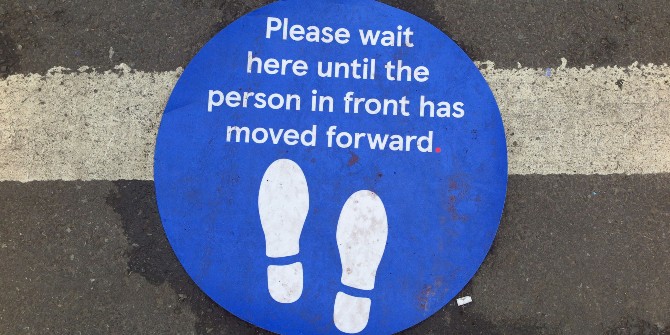Myanmar made significant progress in the 2010s, but the effects of the pandemic and a military coup in February 2021 are reversing those gains. Zlatko Nikoloski (LSE) says poverty rates could double by 2022.
Beginning in 2011, Myanmar undertook a journey of triple transitions—towards peace in the border areas; a move to democratic governance; and establishing a nascent market-oriented economy. The economic reforms and trade deregulations that followed resulted in rapid growth and contributed to a significant reduction in poverty rates. In 2017, Myanmar had a poverty rate of 24.8 percent (using the national poverty line as the benchmark), down from 48.2 percent in 2005.
Despite improvements in well-being, vulnerabilities have remained. One third of the population was already subsisting on low levels of consumption that put them at risk of falling into poverty. Moreover, a significant share of household income was precarious, mainly generated from small and informal business activities. Any negative shock and lack of appropriate coping mechanisms could easily push these households below the poverty line and eventually lead to lasting setbacks in achieving the Sustainable Development Goals (SDGs).
Reduced incomes and minimal coping mechanisms among vulnerable households, in the wake of the COVID-19 pandemic, have set the stage for an estimated increase in the poverty rate from 6 to potentially 11 percentage points, by the end of 2020. The Household Vulnerability Survey (2020) shows that containment measures have been particularly harmful to small-scale, family-owned businesses, further increasing the vulnerability of the households owning them. More than four-fifths (83.3 percent) of households have reported a drop in income since the beginning of 2020. Evidence also pointed to disruptions across sectors and reduced remittances due to global and regional lockdowns.

The ongoing political crisis will, doubtless, further compound the socioeconomic impact of the pandemic, reducing incomes. In the worst-case scenario, nearly half of the population of Myanmar (48.2 percent) will live in poverty (compared to the 24.8 percent in 2017), reversing gains made since 2005. If the situation on the ground persists, the poverty rate could double by the beginning of 2022. By then, the shock from the crisis will have resulted in significant losses of wages and income, particularly from small businesses, and a drop in access to food, basic services and social protection.
One year into the pandemic, the country faced a further shock on 1 February 2021, as the Myanmar military staged a coup d’état to overthrow the democratically elected government. The takeover paved the way for violent military and police crackdowns against protesters. Within a period of two months, more than 700 people are reported to have been killed and thousands detained. Moreover, the economy is facing significant risks of a collapse; in the East Asia and Pacific Economic Update (April 2021), the World Bank projected an economic contraction of 10 percent in 2021 due to a combination of substantial employment and income losses, government relief not matching earning losses, stimulus not offsetting output shortfalls and public investment not being accelerated and scaled up. Recent media reports have highlighted a range of stress points emerging concurrently and stifling economic activities, including a virtual standstill in banking operations since 1 February, which has adversely impacted business operations and credit.
Furthermore, around 80 percent of Myanmar’s trade is seaborne and the United Nations Development Programme estimates that the trade volume in ports has dropped by between 55 and 64 percent in the two months following the military takeover, due to delays in government clearance, logistical disruptions on account of political unrest and shipping lines temporarily suspending work, amongst other factors. All these reports indicate that Myanmar is approaching the point of economic collapse.
Two scenarios (optimistic and pessimistic) were developed to project the effects of the coup, depending on the impact of the unfolding situation on household incomes. Unlike with COVID, where the shock is assumed to be temporary in nature, in both scenarios associated with the takeover we assumed a protracted downward shift in consumption patterns. The pessimistic scenario would see poverty rates almost doubling compared to the Myanmar Living Conditions Survey 2017 poverty baseline—a regression to where the country was in 2005.
Women and children are expected to bear the heaviest brunt of the combined impact of COVID and the political crisis. The effects of the pandemic, amplified by the effects of the overthrow of the civilian government, are likely to lead to a disproportionate increase in urban poverty. Urban areas, where most of the income-generating activities of the near poor are, have been ground zero for the pandemic and the focus of the most severe crackdowns. Child poverty is expected to remain high, with more than half of children living in poverty in the pessimistic scenario. This will further exacerbate the intergenerational transmission of poverty, which, coupled with potential school closures, may have a devastating impact on the human capital of the next generation.
Finally, the compounded shock is particularly likely to affect women (with female-headed households more likely to be poor at the outset). This is largely due to the types and sectors of female employment in Myanmar. This amplification of the pre-existing vulnerabilities will undoubtedly have significant impacts on household income and well-being, and on access to and benefits gained from social services, particularly in health and education.
Given the present trends, based on the data and evidence available at this time, Myanmar is at risk of losing over a decade of hard-won gains in the fight against poverty. Without rapid corrective actions on economic, social, political and human rights protection policies, these scenarios will put Myanmar’s efforts to achieve the Sustainable Development Goals by 2030 well out of reach.
This post represents the views of the author and not those of the COVID-19 blog, nor LSE. It is an edited extract from a UNDP report, COVID-19, Coup d’Etat and Poverty: Compounding Negative Shocks and their Impact on Human Development in Myanmar (April 2021).





